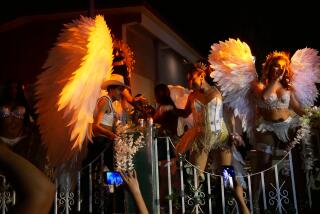Muscovites Gawk as U.S. Opens High-Tech Exhibit
- Share via
MOSCOW — There was much to gawk at Thursday, and Soviet citizens gawked--at personal computers, a Plymouth Voyager van, a supermarket checkout counter, a do-it-yourself device for checking blood pressure and videotapes of space shots and a Super Bowl football game.
It was opening day of the first official exhibit since 1979 to result from a Soviet-American exchange program, a presentation by the U.S. Information Agency called “Information USA--Linking People and Knowledge.”
The idea is to show the Soviets how Americans benefit from communications technology and information systems, in schools and offices, on the farm, in factories--just about everywhere.
Wick Opens Exhibit
The exhibit was opened by USIA Director Charles Z. Wick, who arranged for President Reagan to deliver a welcoming message by videotape, simultaneously translated into Russian.
In return, a Soviet exhibit will tour the United States later this year.
The first such exchange between the two countries took place in 1959 and led to the famous “kitchen debate” between Vice President Richard M. Nixon and then-Soviet leader Nikita S. Khrushchev.
Many facets of American life are being displayed by the high-tech equipment, but the job is probably being done even better by the Russian-speaking Americans who have come with the exhibit. They will tour with it for the next 18 months as it moves from Moscow to Leningrad to Kiev, Rostov, Minsk, Tbilisi, Tashkent and Irkutsk.
Ready for Questions
The 14 women and 10 men serving as guides are all prepared to answer questions about the exhibit and about American life in general.
They are also expected to learn a great deal about the Soviet Union and its people, ordinary citizens whose views are not normally available.
“I’m really looking forward to this year,” said Michael Malara, 29, a Californian who lives on the Palos Verdes Peninsula. “I think the Russians and the Americans have a lot to learn from one another.”
Malara has a degree in Russian studies from USC and a master’s degree from New York University. He studied Russian at Moscow’s Pushkin Institute in 1984 and 1985.
He shows people at the exhibit how computers can be used to make designs and blueprints, and he allows them to print out their creations as souvenirs.
“I’m used to being asked questions about America,” he said. “Russians do know something about the U.S., but it’s pretty much one-dimensional. They like to know what things cost, how much you pay for a car, an apartment, a color television set--and about whatever larger issues are currently being played on Soviet television concerning America.
‘Russians Fascinated’
“I have found Russians fascinated about American life, and I try to give them an accurate but rounded picture. Right now, there’s a lot of concern about AIDS here because there is so much about American problems with the disease on Soviet television.”
Standing behind the checkout counter was Janice Eklund, 25, of Bloomington, Ind., a Russian specialist with degrees from Indiana University and Bates College at Lewiston, Me. She was showing Soviet visitors how computers serve as cash registers, with optic scanners that read the coded prices on cans and bottles and packages.
“I’m a little nervous,” she said. “It’s my first day, but I think it will be a lot of fun, especially here at this food stand.”
No Peanut Butter
But a senior official from the Foreign Ministry, Gennady I. Gerasimov, who spent five years in New York City working for a Soviet news agency, said later with a smile:
“I went up to the stand and asked for one of my favorite foods--peanut butter. And she said blushingly, ‘We don’t have any.’
“I said, ‘What kind of an American supermarket is this?’ ”
Charles Strouse, 28, a writer from St. Paul, Minn., said he thinks “this is a helluva way of getting around the Soviet Union.”
More to Read
Sign up for Essential California
The most important California stories and recommendations in your inbox every morning.
You may occasionally receive promotional content from the Los Angeles Times.













